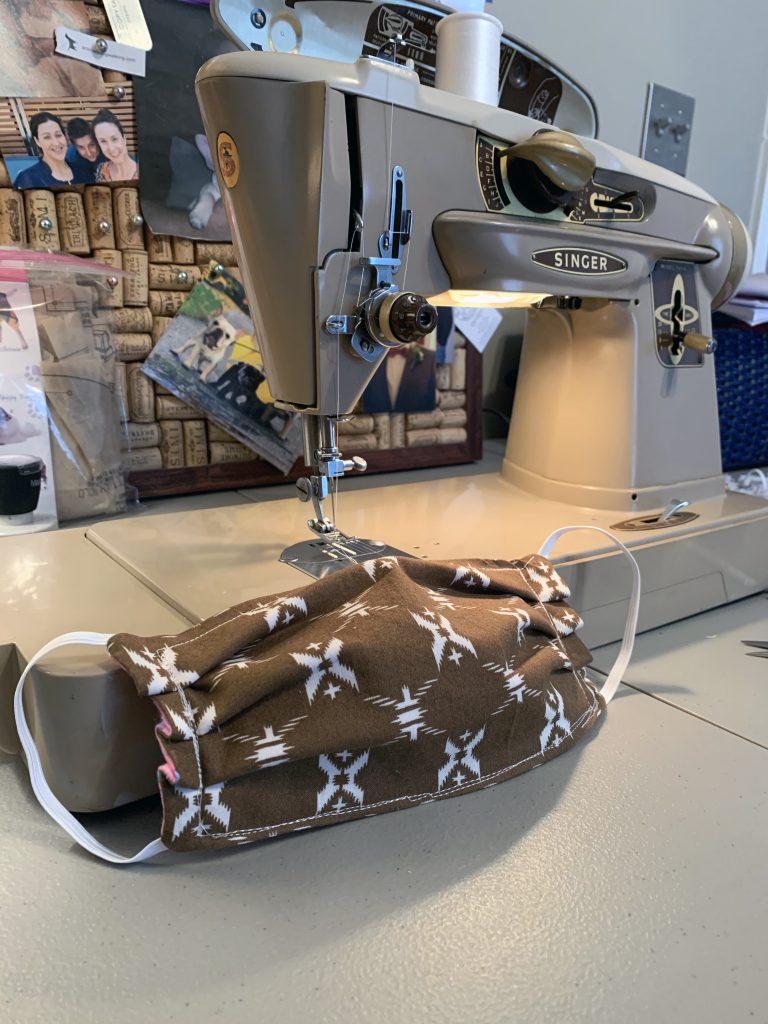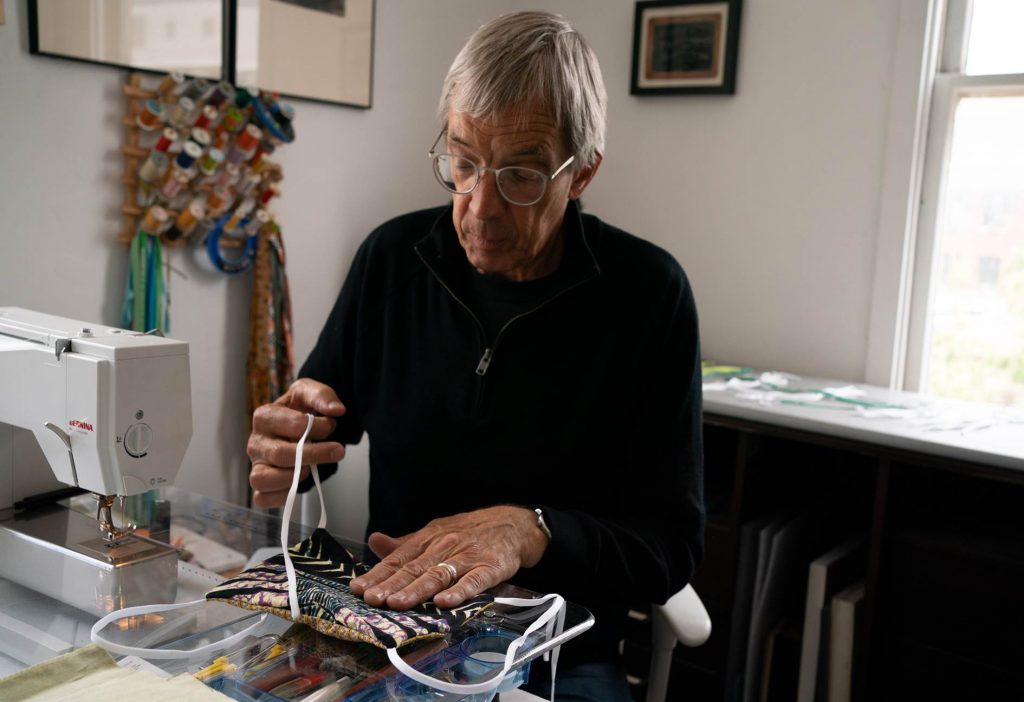Subscriber Benefit
As a subscriber you can listen to articles at work, in the car, or while you work out. Subscribe NowWhen the pandemic shut down businesses in mid-March, people who ran sewing stores, sold sewing machines and did workshops were in a panic about how they would stay afloat.
“Then the mask thing happened,” says Heather Grant, executive director of the Strategic Sewing & Quilting Summit.
“The mask thing” began in early April after the Centers for Disease Control and Prevention recommended that people wear face coverings when going out in public to slow the spread of the novel coronavirus. They were not suggesting the hospital-grade variety (which were in short supply and were needed for health-care workers) but basic cloth masks that could be sewn at home.
“People dragged machines out of their closets or went online to buy new ones,” Grant says, and stores started selling out of sewing machines, dark fabrics and elastic.
Bryan Morris, co-owner of the four Washington, DC-area Brothers Sew & Vac stores, says each of his stores was getting 10 or 20 calls a day from people looking to buy or repair sewing machines. “I was also getting calls from some medical facilities looking for people to sew masks,” he says. Even now, he says, demand hasn’t slowed down.
As the stay-at-home weeks wore on, novice and expert sewers alike found themselves with more time to work on projects. “People were finishing quilts they had in a drawer for years,” Grant says.
Mathew Boudreaux, who lives outside of Portland, Ore., designs fabrics and gives classes all over the country. He has started finishing projects, such as crocheting afghans, that he had never had time to get to. “It was a way not to have to think,” he says. “I didn’t want to come up with new projects. And I didn’t have to think of the pandemic for a bit.”
Singer, which sells 56 models of sewing machines ranging from $99 to $400, saw an immediate spike. “Our business grew quickly during the pandemic, resulting in almost every model being out of stock in early April,” says Dean Brindle, chief marketing officer of SVP Worldwide, Singer’s parent company. Singer posted mask patterns, including ways to personalize them with embroidery, upcycling ideas and sewing tutorials to its website and social media.
“We are continuing to look for opportunities to engage with consumers differently,” Brindle says, noting that the company has attracted younger customers and more male customers since the pandemic began, including boys who have taken up sewing to make masks. “Roughly 20 percent of our consumers have been men,” Brindle says.
At Bernina, the entry-level Bernette machine (about $199) sold out in a few weeks, says Paul Ashworth, chief executive and president of Bernina of America. “Some people hauled out their 10-year-old machines and realized they wanted new ones,” he says. “It created a whole snowball effect, and by the end of April, you really could not find a single sewing machine below $500 in the United States,” he says. Today, there remain massive back orders for machines below $1,000. To reach new and younger sewers, he says the company started an Instagram TV channel to post tips.
As the need for masks exploded, sewers became rock stars.
Elisabeth Woo, a quilter from Irvine, Calif., had never sewn a face mask but quickly figured it out. “People came out of the woodwork, even people who hadn’t talked with you in ages. They said, ‘You know how to sew. Can you make me a mask?’ Before I knew it, I had made more than 100 face masks,” she says. The work took its toll. “The next stage was real emotional burnout. It was so exhausting. Normally, you are used to sewing as a form of stress relief and a creative outlet. Now, you were focused on something bad happening in the world, and you had to use your time and fabric and resources to keep yourself safe.”
Joe Cunningham of San Francisco, who has been quilting for 40 years, lost all of his teaching gigs and seminars for the rest of the year. Cunningham, whose quilts sell for about $9,500, does four-day retreats that can cost $1,400. After making more than 100 masks, he realized he was going to have to restructure his business. He did a lecture and studio tour on Zoom, and then he hosted his first online class. He was skeptical as to how many people would pay $35 for it, but he was thrilled that 268 people signed up for the webinar. “It’s not like I’m Elvis Presley,” he says, “but that’s a cheap workshop with me.”
He’s planning on more online work. “This pandemic could sure change my business,” he says. “This forced me to learn online teaching, and now I actually have more time to quilt.”

Meanwhile, non-sewers or novices also stepped up to the plate. Tiffany Cagle-Schrift, 39, a neurotherapist in Winston-Salem, N.C., had mentioned to her husband that someday she might want to learn to sew, so he got her a restored 1960s Singer machine last Christmas. Her grandmother, 88, a professional seamstress, was able to give her a few lessons after the holiday, but then she had a stroke. (She’s on the mend now.) Cagle-Schrift didn’t go back to the machine until late March, when she realized she needed to do something positive. “You don’t necessarily know where to put your energy or anxiety, but making something that could potentially help does make you feel better,” she says. She made almost 300 masks, donated most of them, and is now looking into making things for other charities. Oh, and she might try her hand at scarves for her three dogs.
It’s nothing new for people to turn (or return) to sewing in uncertain times. “After the financial crash in 2008, a lot of people turned to sewing on Flickr to be inspired by what others were doing,” says Aneela Hoey, a British pattern maker and Instagram influencer whose business is Comfort Stitching. Now, she says, the community keeps growing as many makers share ideas on Instagram. She creates and writes books of patterns for sewing and embroidery and sells patterns for tote bags, organizing pouches and other functional items. “My patterns have been doing well during the pandemic; [other sewers] tag me and give a shoutout to my work,” she says.
Machine makers such as Bernina say parents are using entry-level machines to teach children to sew while stuck at home.
Latifah Saafir, 44, who has been sewing since she was 10, designs fabrics and patterns for children. “There’s not too much out there in product lines for kids, so parents are happy to find these,” says Saafir, who is co-founder of the Modern Quilt Guild. She says stores have increased their orders of her designs, hearing from parents that they needed ways to keep kids occupied. “I have one customer who ordered three patterns directly from me so she could teach sewing to her grandkids on Zoom,” she says. She herself has switched to Zoom events for her lectures to quilt guilds and her classes.
Industry executives are betting people are not going to pack away their machines anytime soon. “People are not returning to life as normal for a while,” Brindle says. “We are already in month four, and a lot of people who did come back to sewing will continue.”
Like riding a bike, Woo says, “when you learn how to thread a sewing machine, you never forget it. The machine is like an old friend who is waiting for you to come back to it. I don’t know how many people will stick with it, but I think many will. It’s satisfying to have your own time and then have something tangible to show for it. You can also give something beautiful to someone else, to comfort them.”
Please enable JavaScript to view this content.

